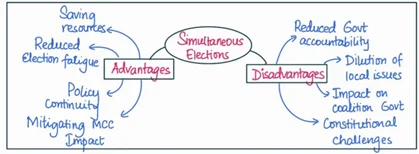Answer:
| Approach:
Introduction
- Begin with a brief explanation of simultaneous elections and their significance in the context of India’s electoral system.
Body
- Divide the body into two main sections:
- Advantages of simultaneous elections.
- Disadvantages of simultaneous elections.
Conclusion
- Highlight the importance of public consultations and expert opinions in determining the best course of action for India’s democratic process.
|
Introduction:
Simultaneous elections, also known as “One Nation, One Election,” refer to the proposal of conducting both Lok Sabha and State Assembly elections concurrently in India. This concept aims to streamline the electoral process, save resources, and reduce the disruptions caused by frequent elections.
Body:

Advantages of simultaneous elections:
- Saving resources: Conducting simultaneous elections can save a significant amount of financial and administrative resources, as well as time spent in electioneering.
- Policy continuity: Simultaneous elections can reduce the impact of election-driven policymaking, allowing governments to focus on long-term planning and implementation rather than short-term political gains.
- Reduced election fatigue: Frequent elections can lead to voter fatigue, which may result in low voter turnout.
- Mitigating the ‘Model Code of Conduct’ impact: The Model Code of Conduct, enforced during elections, can hinder developmental projects and policy decisions.
Disadvantages of simultaneous elections:
- Reduced government accountability: Simultaneous elections can reduce the number of opportunities for citizens to express their dissatisfaction with the government’s performance.
- Dilution of local issues: Combining national and state elections may lead to a focus on national issues at the expense of local concerns.
- Impact on coalition governments: In case of a hung Parliament or Assembly, the formation of a coalition government may become more challenging in a simultaneous election setup.
- Constitutional challenges: Implementing simultaneous elections may require significant amendments to the Constitution, which could be a complex and time-consuming process. Additionally, it might disrupt the federal structure of the country.
Conclusion:
While simultaneous elections can save time and resources, it may also impact government accountability to the people. It is essential to weigh these advantages and disadvantages carefully before implementing such a system. Public consultations and expert opinions must be considered to ensure the best possible outcome for the country’s democratic process.
